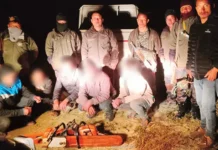RUPA, 18 Oct: India is giving a major push to boosting connectivity and use of high-tech surveillance along the nearly 1,350-km line of actual control (LAC) in the Arunachal Pradesh sector to ensure quick mobilization of troops and heavy weaponry to deal with any eventuality in the face of the standoff with China in eastern Ladakh.
As part of the mega plan, around 20 bridges, a number of tunnels, airbases and several key roads are being developed in strategically key areas in Arunachal to bolster the overall military preparedness, officials said on Monday.
Major General Zubin A Minwalla, General-Officer-Commanding of the 5 Mountain Division, said the focus has been to further strengthen road infrastructure as well as the use of high-tech surveillance equipment to create more battlefield transparency.
The 5 Mountain Division is tasked with keeping vigil over areas from Bumla to west of Bhutan and is considered one of the most critical formations of the Indian Army.
“The adversary cannot surprise us now. We are confident of what our goal is and we are not going to be surprised by them,” he told a group of reporters while elaborating the steps being taken by the Indian Army to boost military preparedness.
“We are following an approach of confidence in dealing with any possible situation. The Indian Army’s focus has been on maintaining the sovereignty of the land,” Maj Gen Minwalla said.
He said there has been a “tremendous push” on infrastructure development by the Border Roads Organization (BRO) and the civilian government.
“There is no such increase in deployment (of troops). We are creating more (battlefield) transparency through technology. We are using technology to increase our awareness of the entire situation,” he said.
Maj Gen Minwalla said that, besides road connectivity, the larger push has been on use of high-tech equipment for surveillance and to enhance assets of the army aviation, so that they can act as a “force multiplier.”
“We are giving more push in terms of enhancing capabilities by our own means of technology and processes in terms of infrastructure,” he said.
“We are not reacting. We have our own plans and are confident of meeting our own goals and targets in terms of capability building,” he said when asked whether India’s overall approach is reactionary towards China.
Anant Kumar Singh, an engineer with the BRO, said that around 20 bridges are being constructed besides many key roads and tunnels.
He said the tunnels in Nechiphu and Sela Pass will be ready much ahead of their scheduled timelines for completion in August next year.
The major road projects include construction of a road from Zero Point near Tenga to Itanagar, and another one called ‘western axis road’ from Shergaon to Tawang.
“These two roads will be crucial for overall capability enhancement,” said Singh.
As tensions with China increased following the eastern Ladakh row last year, India ramped up overall deployment of troops along the LAC, besides speeding up infrastructure development to gain tactical advantage. The army is also cranking up its day and night surveillance over the LAC in the region using a fleet of remotely piloted aircraft.
A sizeable fleet of Israeli-made Heron medium-altitude long endurance drones is carrying out round-the-clock surveillance over the LAC in the mountainous terrain and sending crucial data and images to command and control centres.
Along with the drones, the Indian Army’s aviation wing has also been deploying the weapon system integrated variant of the advanced light helicopter Rudra in the region, adding more teeth to its tactical missions in the region, they said.
The government is also working on connecting Tawang with a railway network as part of a decision to enhance infrastructure in the region. (PTI)



